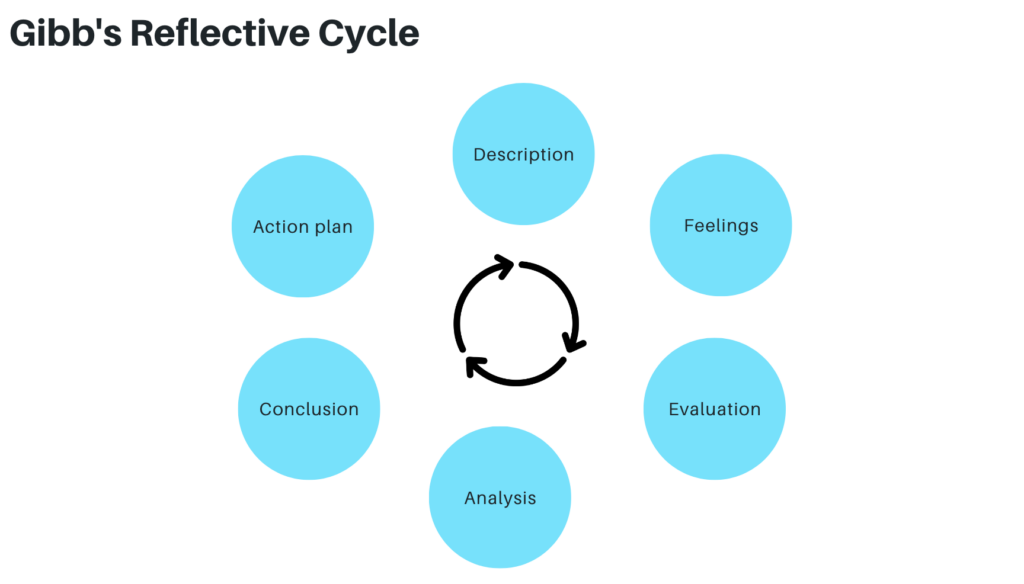
As leaders, we’re always seeking ways to improve ourselves and our performance. One way to do that is by reflecting on our experiences and learning from them. That’s where the Gibbs Reflective Cycle comes in – a framework that can help structure and enhance our reflective practice.
Let’s dive into what the Gibbs Reflective Cycle is and how to use it effectively.
What is the Gibbs Reflective Cycle?
Developed by Graham Gibbs in 1988, the Gibbs Reflective Cycle is a six-stage model that can be used to guide reflection on a particular experience or event. The cycle involves reflecting on the experience, analysing feelings, evaluating the experience, analysing the experience from different perspectives, drawing conclusions, and developing an action plan for future situations.
The six stages of the Gibbs Reflective Cycle are:
- Description
- Feelings
- Evaluation
- Analysis
- Conclusion
- Action Plan
Let’s look at each stage in more detail. But before doing so, it’s essential to take time and create space to reflect. I strongly recommend writing down each step of the process to help the understanding of the problem and how to solve it.

Stage 1: Description
The first stage of the Gibbs Reflective Cycle involves describing the experience or event. This includes providing details about what happened, when it happened, and who was involved. By describing the situation in detail, we can gain a better understanding of what occurred and what impact it had.
To help with the description, consider asking questions like:
- When and where did this happen?
- Why were you there?
- Who else was there?
- What happened?
- What did you do?
- What did other people do?
- What was the result of this situation?
Stage 2: Feelings
The second stage involves exploring and analysing the emotions and feelings that were experienced during the event. This includes both positive and negative emotions and can help us to understand our own emotional responses to situations.
Consider these questions to guide your reflection:
- What did you feel before this situation took place?
- What did you feel while this situation took place?
- What do you think other people felt during this situation?
- What did you feel after the situation?
- What do you think about the situation now?
- What do you think other people feel about the situation now?
Stage 3: Evaluation
The third stage involves evaluating the experience, both objectively and subjectively. This includes looking at the positive and negative aspects of the experience and considering what could have been done differently.
Ask yourself these questions to evaluate the experience:
- What was positive about this situation?
- What was negative?
- What went well?
- What didn’t go so well?
- What did you and other people do to contribute to the situation (either positively or negatively)?
Stage 4: Analysis
The fourth stage involves analysing the experience from different perspectives. This includes considering the perspectives of others involved in the situation and looking at the situation from different angles.
Consider these questions:
How could this have been a more positive experience for everyone involved?
If you were faced with the same situation again, what would you do differently?
What skills do you need to develop to handle this type of situation better?
One method that we like to use is box breathing before reviewing the situation, read more about box breathing here.
Stage 5: The Conclusion
This stage is all about wrapping up the analysis and evaluation of the experience. You get to reflect on what you learned from the experience and how you can apply it to similar situations in the future. So, ask yourself, “If I had to do the same thing again, what would I do differently?” This will help you identify areas for improvement.
It’s also important to think about how you can develop the skills you need to handle similar situations better in the future. So, ask yourself, “How will I develop the required skills I need?” This will help you plan your professional development.
Lastly, it’s essential to think about how you can ensure that you can act differently next time. So, ask yourself, “How can I make sure that I can act differently next time?” This will help you develop a plan of action that you can use if a similar situation arises in the future.
Stage 6: The Action Plan
The final stage is all about putting your reflections into action. This involves identifying areas for improvement and making a plan of action that you can use in the future if a similar situation arises. The Gibbs Reflective Cycle is an excellent tool for structuring your reflections and enhancing your personal and professional development.
By regularly reflecting on your experiences using the Gibbs Reflective Cycle, you can develop the skills and insights that will serve you both in your current roles and in your future careers. Reflection is a crucial part of developing as a professional, and the Gibbs Reflective Cycle provides a valuable framework for structuring reflections to gain the greatest benefit from them.
I personally used this reflective cycle with the business dads that I coach during the pathway, if you want more information about the pathway, take a look. You can see how I used this tool with Stuart a business dad, here where we were able to reflect on his day-to-day actions. Sometimes it is easy to go from day to day without changing anything.
The definition of insanity is doing the same thing over and over and expecting different results.
–Albert Einstein
Conclusion – why use the Gibbs Reflective Cycle
In conclusion, the Gibbs Reflective Cycle is an invaluable tool for professionals who want to improve their personal and professional development. It provides a structured approach to reflection that can help us better understand our experiences and their impact on ourselves and others. For me, I try to use the cycle after tough conversations, projects or coaching sessions. As a coach, it can be very easy to go from one session to the next without stopping and reflecting. This can be a similar problem in every industry or profession.
So, keep reflecting and using the Gibbs Reflective Cycle to enhance your professional growth!
Contact us here at [email protected] or book a call.
Progress over perfection
Lee
